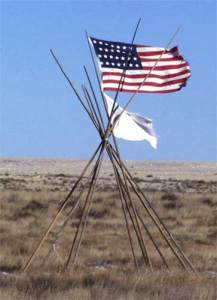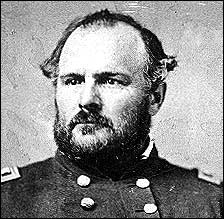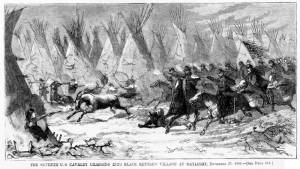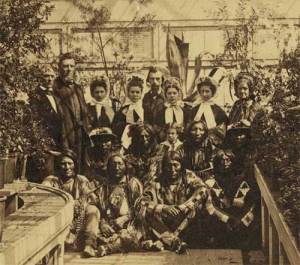Tribe massacred despite American flag | Sand Creek

In late 1864, the Civil War was nearing its end. For nearly four years, American flags and Confederate banners had been flying above frays fought mainly on the East Coast. Another battle, which occurred in the Far West, involved flags that were ignored.
Unrelated to the war, Federal troops descended on hundreds of Cheyenne and Arapaho Indians encamped along Sand Creek in Colorado. As reported by Smithsonian Magazine in its current issue, “their chiefs had recently sought peace in talks with white officials and believed they would be unmolested in their isolated camp.”
Their belief was violently refuted when U.S. cavalrymen raced toward the camp as dawn broke on November 29, 1864. In an attempt to forestall the attack, tribal chiefs quickly hoisted both an American flag and a white flag as tokens of their peaceful intentions.

But nothing slowed the oncoming soldiers, who were led by Col. John Chivington. According to the Smithsonian, his men killed “at least 150 Indians, most of them women, children and the elderly.” Their bodies were then desecrated.
When news of the reprehensible assault reached the nation’s newspapers, reactions to it were polar opposites. The Rocky Mountain News in Denver crowed, “The Savages Dispersed! 500 Indians Killed.” An editorial praised the attack as a “needed whipping of the ‘red skins.’”

A far different attitude came from The Atchison Champion in Missouri under the title, “The Hellish Massacre of Indians.” It reported the opinion of an Army officer that Chivington’s actions at Sand Creek were “the most cold-blooded, revolting, diabolical atrocity ever conceived by man or devil. The sworn accounts of witnesses of the affair [tell of] indiscriminate, wholesale murder of men, women and children….The flag and uniform of the United States were disgraced by acts of fiendish barbarity.”

The officer was also enraged by a report that “all these atrocities were committed on a band of Indians, who had, voluntarily, entrusted themselves to the protection of the Government, received assurances of care, and who had flying above the encampment at that time a white flag and a national banner, given them by the military authorities…with the promise that this was to be to them security and guardianship as long as they remained under it and continued friendly.”
In marking the 150th anniversary of the Civil War, Americans should also remember the shame of Sand Creek.
